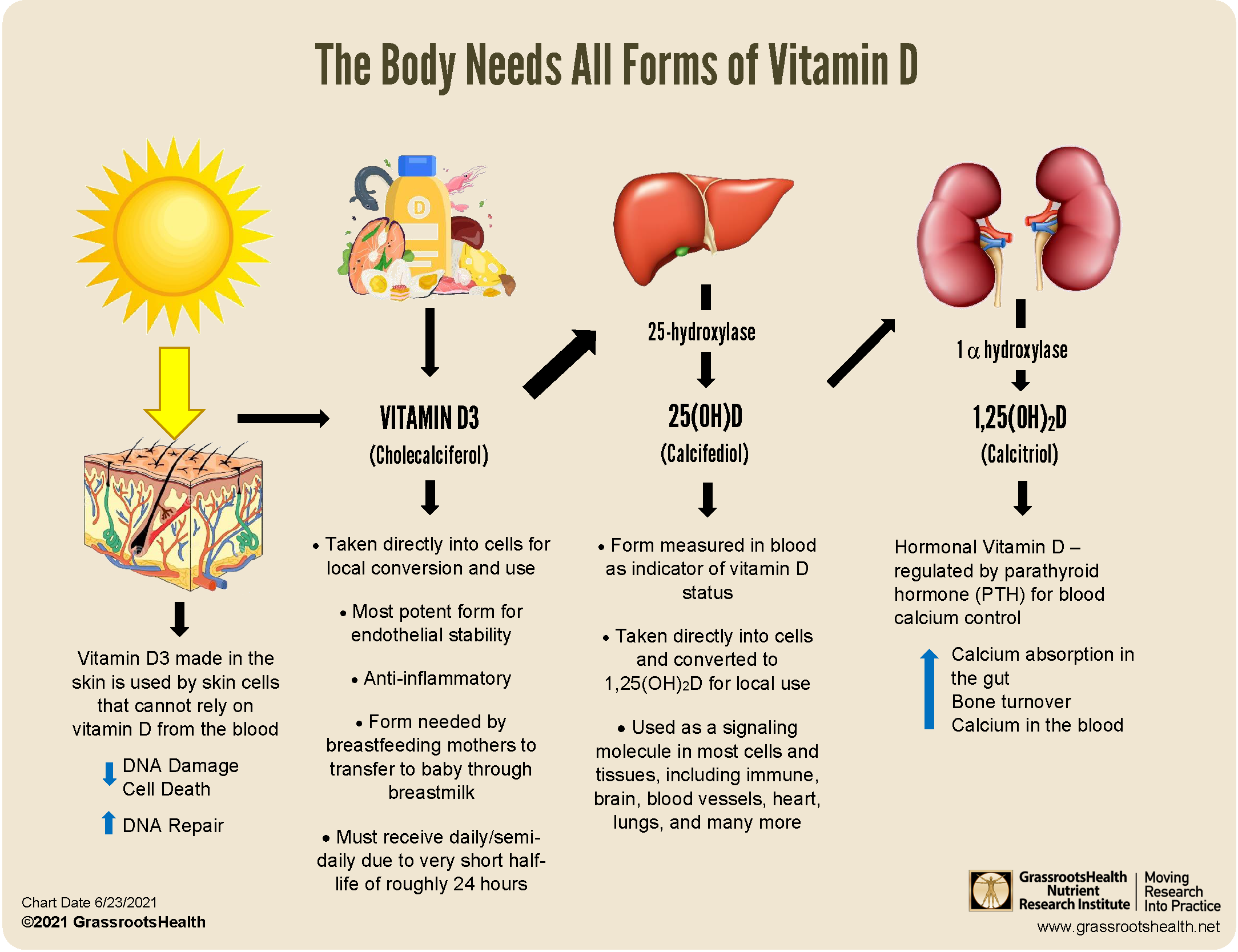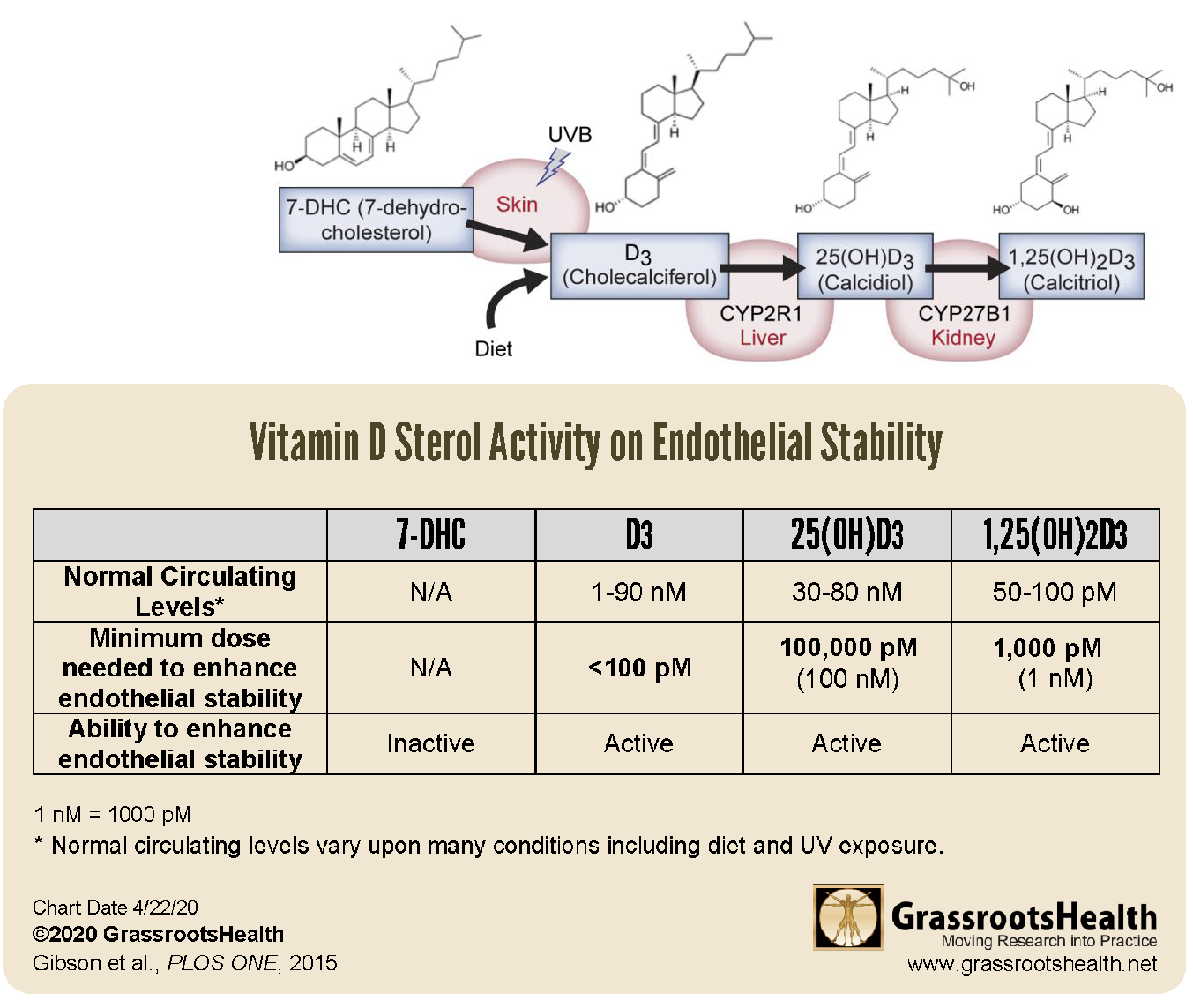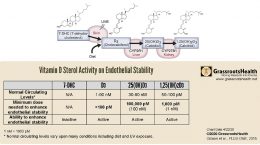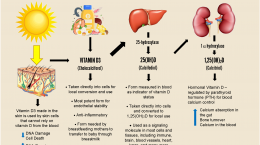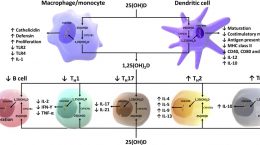Published on April 29, 2022
Dispelling a common misconception about vitamin D3, and adding to the importance of daily dosing through sun, supplement, and/or diet
Key Points
- While many people call the hormonal form 1,25-dihydroxyvitamin D (which is made by the kidneys and circulated in the blood) the “active” form of vitamin D, it is absolutely essential to understand that this form of vitamin D is not the only one that has specific and important effects within the body
- In addition to being delivered to the liver for conversion to 25(OH)D, vitamin D3 is also delivered directly to all tissues of the body; many of these tissues, such as breast, colon, prostate, and brain, can convert vitamin D3 to its other forms directly, and it is through this process that vitamin D (as vitamin D3, the form we make from the sun or get from food and supplements) can help enable the cells to fight against infections, disease, and autoimmune disorders
- Vitamin D3 itself is actively used by the cells as a “potent and general mediator of endothelial stability at physiologically relevant levels;” while each form of vitamin D can increase stability within minutes, inhibiting permeability of the endothelial and vascular lining, and reversing inflammation, vitamin D3 had the most potent effect – more than 10 times more potent than 1,25(OH)2D and more than 1,000 times more potent than 25(OH)D
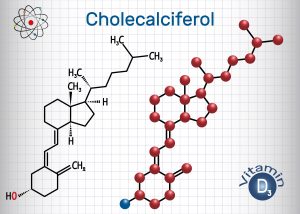 “Vitamin D” is a term that refers to several compounds, most often Vitamin D3 (Cholecalciferol – the form we get from food, sun, and supplements), 25-hydroxyvitamin D [25(OH)D or Calcifediol – the form we measure in the blood], and 1,25-dihydroxyvitamin D [1,25(OH)2D or Calcitriol –referred to the hormonal form of vitamin D]. The chart below illustrates each of these different forms of vitamin D and some of their specific actions.
“Vitamin D” is a term that refers to several compounds, most often Vitamin D3 (Cholecalciferol – the form we get from food, sun, and supplements), 25-hydroxyvitamin D [25(OH)D or Calcifediol – the form we measure in the blood], and 1,25-dihydroxyvitamin D [1,25(OH)2D or Calcitriol –referred to the hormonal form of vitamin D]. The chart below illustrates each of these different forms of vitamin D and some of their specific actions.
While many people call the hormonal form 1,25-dihydroxyvitamin D (which is made by the kidneys and circulated in the blood) the “active” form of vitamin D, it is absolutely essential to understand that this form of vitamin D is not the only one that has specific and important effects within the body.
Could There be More to Native Vitamin D3 Than Previously Thought?
What has not been appreciated until relatively recently is that, in addition to being delivered to the liver for conversion to 25(OH)D, vitamin D3 is also delivered directly to all tissues of the body. Many of these tissues, such as breast, colon, prostate, and brain, can convert vitamin D3 to its other forms directly within the tissue. It is through this process that vitamin D (as vitamin D3, the form we make from the sun or get from food and supplements) can help enable the cells to fight against infections, disease, and autoimmune disorders.
Vitamin D3 has been shown to have especially profound effects on endothelial and vascular stability. Endothelial cells form the inner lining of the heart and blood vessels (veins, arteries, capillaries) and the lymphatic system. The disruption in the tightness and stability of endothelial and vascular tissues is common among many inflammatory based diseases. This disruption contributes to dysfunctional nutrient exchange, inflammatory cell migration, and abnormal clotting. Addressing this disruption has been shown to lessen the effects from the inflammatory diseases involved.
Vitamin D3 – The Most Potent Form of Vitamin D for Endothelial Stability
A study by Gibson et al. looked at a genetic inflammatory disease called cerebral cavernous malformation (CCM) to identify potential suppressors of the disease and resulting destabilization of the endothelial membranes. They found vitamin D3, the pre-converted form that our bodies get from food, supplements and sun, to have such effects both in vitro and in vivo. In a subsequent study, the researchers investigated whether vitamin D3 and its metabolites could provide general endothelial stability outside of the genetic disease model.
The authors discovered that, not only is vitamin D3 itself needed and taken in by the cells, it is also actively used by the cells as a “potent and general mediator of endothelial stability at physiologically relevant levels.” They found that each form of vitamin D (vitamin D3, 25(OH)D and 1,25(OH)2D) increased stability within minutes, inhibiting permeability of the endothelial and vascular lining, and reversing inflammation, all of which resulted in reduced leakage into surrounding tissues. Of particular note in the results was that vitamin D3, which was previously thought to be inactive, had the most potent effect – more than 10 times more potent than 1,25(OH)2D and more than 1,000 times more potent than 25(OH)D. They also discovered that vitamin D3 directly inhibited the destabilizing effects of multiple pro-inflammatory signals, such as interleukin-1b, tumor necrosis factor-a, and bacterial lipopolysaccharides.
Overall, the data from this study shows that vitamin D sterols, especially vitamin D3 itself, acts directly to suppress and prevent destabilization of the endothelial membranes and its negative effects. This direct action of vitamin D3, along with the knowledge that the half-life of vitamin D3 in the body is roughly 24 hours, is further evidence in support of obtaining a daily dose of vitamin D3 through supplements, diet, and/or UVB exposure.
Are You Low in Vitamin D? Check Your Level from Home
 Having and maintaining healthy vitamin D levels and other nutrient levels can help improve your health now and for your future. Choose which additional nutrients to measure, such as your omega-3s and essential minerals including magnesium and zinc, by creating your custom home test kit today. Take steps to improve the status of each of these measurements to benefit your overall health. With measurement you can then determine how much is needed and steps to achieve your goals. You can also track your own intakes, symptoms and results to see what works best for YOU.
Having and maintaining healthy vitamin D levels and other nutrient levels can help improve your health now and for your future. Choose which additional nutrients to measure, such as your omega-3s and essential minerals including magnesium and zinc, by creating your custom home test kit today. Take steps to improve the status of each of these measurements to benefit your overall health. With measurement you can then determine how much is needed and steps to achieve your goals. You can also track your own intakes, symptoms and results to see what works best for YOU.
Enroll in D*action and Test Your Levels Today!


